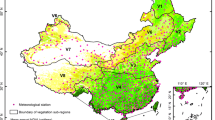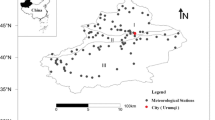Abstract
Three methods were used to distinguish the characteristics of changes in climate variability and normalized difference vegetation index (NDVI) during the period from 1982 to 2000 in China. Great changes in climate variability and an increased trend in NDVI were observed. The changes in precipitation variability were greater than the changes in temperature variability in each month, which is attributed to changes in the monsoon system in East Asia. The abrupt changes in climate and NDVI were more significant in 1983 than in the other years due to the impacts of El Niño/Southern Oscillation (ENSO). Using these results, the influences of changes in climate variability on vegetation were studied in the whole nation, and eight regions were defined according to the vegetation division map of China. The results show that abrupt climate changes at a small scale cannot cause abrupt NDVI changes directly. At a nationwide level, over a longer time scale the persistence of above/below average temperature determines the changes in NDVI; at a shorter time scale, changes in the magnitude of precipitation influence NDVI significantly. Such regional climate variability affects vegetation in different ways owing to the diversity of vegetation types, climatic conditions and topography of the land.






Similar content being viewed by others
References
Barbosa HA, Huete AR, Baethgen WE (2006) A 20-year study of NDVI variability over the Northeast Region of Brazil. J Arid Environ 67:288–307
Bonan GB, Levis S, Sitch S, Vertenstein M, Oleson KW (2003) A dynamic global vegetation model for use with climate models: concepts and description of simulated vegetation dynamics. Global Change Biol 9:1543–1566
Braganza K, Karoly DJ, Hirst AC, Stott P, Stouffer RJ, Tett SFB (2004) Simple indices of global climate variability and change part: attribution of climate change during the twentieth century. Clim Dyn 22:823–838
Camberlin P, Martiny N, Philippon N, Richard Y (2007) Determinants of the interannual relationships between remote sensed photosynthetic activity and rainfall in tropical Africa. Remote Sens Environ 106:199–216
Crucifix M, Betts RA, Cox PM (2005) Vegetation and climate variability: a GCM modeling study. Clim Dyn 24:457–467
Editorial Committee of Vegetation of China (1980) Vegetation of China, Science Press, Beijing
Fang JY, Piao SL, He JS, Ma WH (2003) Increasing terrestrial vegetation activity in China, 1982–1999. Sci China (C) 47:229–240
Fu C, Wang Q (1992) The definition and detection of the abrupt climatic change. Sci Atmos Sin 16:482–493
Funk CC, Brown ME (2006) Intra-seasonal NDVI change projections in semi-arid Africa. Remote Sens Environ 101:249–256
Gao Q, Yu M, Yang XS (2000) An analysis of sensitivity of terrestrial ecosystem in China to climatic change using spatial simulation. Clim Change 47:373–400
Giorgi F, Bi X, Pal JS (2004) Mean interannual variability and trends in a regional climate change experiment over Europe. I. Present-day climate (1961–1990). Clim Dyn 22:733–756
Holben BN (1986) Characterization of maximum value composites from temporal AVHRR data. Int J Remote Sens 7:1417–1434
Intergovernmental Panel on Climate Change (IPCC). Climate change 2001: the scientific basis. Cambridge University Press, Cambridge, New York
Jiang J, Mendelssohn R, Schwing F, Fraedrich K (2002) Coherency detection of multiscale abrupt changes in historic Nile flood levels. Geophys Res Lett 29:1121–1124
Kogan FN (2000) Satellite-observed sensitivity of world land ecosystems to El Niño/La Nina. Remote Sens Environ 74:445–462
Lucht W, Prentice IC, Myneni RB, Sitch S, Friedlingstein P, Cramer W, Bousquet P, Buermann W, Smith B (2002) Climate control of the high-latitude vegetation greening trend and Pinatubo effect. Science 296:1687–1689
Mann ME (2002) Large-scale climate variability and connections with the middle east in past centuries. Clim Change 33:287–314
Mitchell TD, Jones PD (2005) An improved method of constructing a database of monthly climate observations and associated high-resolution grids. Int J Climatol 25:693–712
Ni J, Sykes MT, Prentice IC, Cramer W (2000) Modeling the vegetation of China using the process-based equilibrium terrestrial biosphere model BIOME3. Glob Ecol Biogeogr 9:463–479
Ni J, Harrison SP, Prentice IC, Kutzbach JE, Sitch S (2006) Impact of climate variability on present and Holocene vegetation: a model-based study. Ecol Model 191:469–486
Notaro M, Liu ZY, Gallimore R, Vavrus SJ, Kutzbach JE, Prentice IC, Jacob RL (2005) Simulated and observed preindustrial to modern vegetation and climate changes. J Clim 18:3650–3671
Piao SL, Fang JY, Ji W, Guo QH, Ke JH, Tao S (2004) Variation in a satellite-based vegetation index in relation to climate in China. Journal of Vegetation Science 15:219–226
Piao SL, Mohammat A, Fang JY, Cai Q, Feng JM (2006) NDVI-based increase in growth of temperate grasslands and its response to climate changes in China. Glob Environ Change 16:340–348
Richard Y, Poccard I (1998) A statistical study of NDVI sensitivity to seasonal and interannual rainfall variations in Southern Africa. Int J Remote Sens 19:2907–2920
Salinger MJ (2005) Climate variability and change: past, present and future—an overview. Clim Change 70:9–29
Sarkar S, Kafatos M (2004) Interannual variability of vegetation over the India sub-continent and its relation to the different meteorological parameters. Remote Sens Environ 90:268–280
Sivakumar MVK, Das HP, Brunini O (2005) Impacts of present and future climate variability and change on agriculture and forestry in the arid and semi-arid tropics. Clim Change 70:31–72
Su MF, Wang HJ (2007) Relationship and its instability of ENSO-Chinese variations in droughts and wet spells. Sci China (D) 50:145–152
Suzuki R, Masuda K, Dye DG (2007) Interannual covariability between actual evapotranspiration and PAL and GIMMS NDVIs of northern Asia. Remote Sens Environ 106:387–398
Swets DL, Reed BC, Rowland JR, Marko SE (1999) A weighted least-squares approach to temporal smoothing of NDVI. In: 1999 ASPRS annual conference, from image to information. Portland, Proceedings. American society for photogrammetry and remote sensing, Bethesda, 17–21 May 1999
Tucker CJ, Newcomb WW, Los SO, Prince SD (1991) Mean and inter-year variation of growing-season normalized difference vegetation index for the Sahel 1981–1989. Int J Remote Sens 12:1133–1136
Wen XY, Wang SW, Zhu JH, Viner D (2006) An overview of China climate change over the 20th century using UK UEA/CRU high resolution grid data. Chin J Atmos Sci 30:894–904
Yang JP, Ding YJ, Chen RS (2006) Spatial and temporal of variations of alpine vegetation cover in the source regions of the Yangtze and Yellow Rivers of the Tibetan Plateau from 1982 to 2001. Environ Geol 50:313–322
Zhang JY, Dong WJ, Fu CB, Wu LY (2003) The influence of vegetation cover on summer precipitation in China: a statistical analysis of NDVI and climate data. Adv Atmos Sci 20:1002–1006
Zhang J, Zhang Q, Yang LH, Li DL (2006) Seasonal characters of regional vegetation activity in response to climate change in West China in recent 20 years. J Geogr Sci 16:78–86
Zhao YX, Wang CY, Wang SL, Tibig LV (2005) Impacts of present and future climate variability on agriculture and forestry in the humid and sub-humid tropics. Clim Change 70:73–116
Zhou LM, Tucker CJ, Kaufmann RK, Slayback D, Shabanov NV, Myneni RB (2001) Variations in northern vegetation activity inferred from satellite data of vegetation index during 1981 to 1999. J Geophys Res 106:20069–20084
Acknowledgments
This study was supported by the Scientific Research Foundation for Dr., Shandong University of Technology (408020). The NDVI data were provided by Quan Wang from Shizuoka University, Japan.
Author information
Authors and Affiliations
Corresponding author
About this article
Cite this article
Meng, M., Ni, J. & Zong, M. Impacts of changes in climate variability on regional vegetation in China: NDVI-based analysis from 1982 to 2000. Ecol Res 26, 421–428 (2011). https://doi.org/10.1007/s11284-011-0801-z
Received:
Accepted:
Published:
Issue Date:
DOI: https://doi.org/10.1007/s11284-011-0801-z




